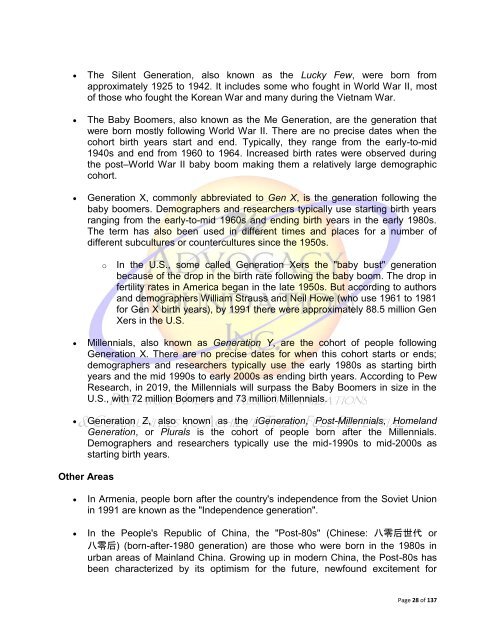Generational Progression
Generational Progression
Generational Progression
You also want an ePaper? Increase the reach of your titles
YUMPU automatically turns print PDFs into web optimized ePapers that Google loves.
The Silent Generation, also known as the Lucky Few, were born from<br />
approximately 1925 to 1942. It includes some who fought in World War II, most<br />
of those who fought the Korean War and many during the Vietnam War.<br />
The Baby Boomers, also known as the Me Generation, are the generation that<br />
were born mostly following World War II. There are no precise dates when the<br />
cohort birth years start and end. Typically, they range from the early-to-mid<br />
1940s and end from 1960 to 1964. Increased birth rates were observed during<br />
the post–World War II baby boom making them a relatively large demographic<br />
cohort.<br />
Generation X, commonly abbreviated to Gen X, is the generation following the<br />
baby boomers. Demographers and researchers typically use starting birth years<br />
ranging from the early-to-mid 1960s and ending birth years in the early 1980s.<br />
The term has also been used in different times and places for a number of<br />
different subcultures or countercultures since the 1950s.<br />
o<br />
In the U.S., some called Generation Xers the "baby bust" generation<br />
because of the drop in the birth rate following the baby boom. The drop in<br />
fertility rates in America began in the late 1950s. But according to authors<br />
and demographers William Strauss and Neil Howe (who use 1961 to 1981<br />
for Gen X birth years), by 1991 there were approximately 88.5 million Gen<br />
Xers in the U.S.<br />
<br />
<br />
Millennials, also known as Generation Y, are the cohort of people following<br />
Generation X. There are no precise dates for when this cohort starts or ends;<br />
demographers and researchers typically use the early 1980s as starting birth<br />
years and the mid 1990s to early 2000s as ending birth years. According to Pew<br />
Research, in 2019, the Millennials will surpass the Baby Boomers in size in the<br />
U.S., with 72 million Boomers and 73 million Millennials.<br />
Generation Z, also known as the iGeneration, Post-Millennials, Homeland<br />
Generation, or Plurals is the cohort of people born after the Millennials.<br />
Demographers and researchers typically use the mid-1990s to mid-2000s as<br />
starting birth years.<br />
Other Areas<br />
<br />
<br />
In Armenia, people born after the country's independence from the Soviet Union<br />
in 1991 are known as the "Independence generation".<br />
In the People's Republic of China, the "Post-80s" (Chinese: 八 零 后 世 代 or<br />
八 零 后 ) (born-after-1980 generation) are those who were born in the 1980s in<br />
urban areas of Mainland China. Growing up in modern China, the Post-80s has<br />
been characterized by its optimism for the future, newfound excitement for<br />
Page 28 of 137

















